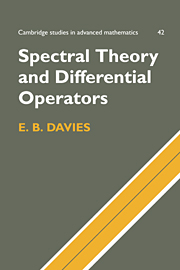2 - The spectral theorem
Published online by Cambridge University Press: 08 January 2010
Summary
Introduction
The general spectral theorem for self-adjoint operators was proved independently by Stone and von Neumann during the period 1929–1932. There have been several other proofs since that time, the most popular being that based upon Gelfand's theory of commutative Banach algebras. There are also several different ways of stating the spectral theorem, one in terms of a functional calculus, one using a family of spectral projections and one in terms of a measure-theoretic representation formula; all of these have advantages.
In this chapter we describe an approach to the spectral theorem which originates from a paper written in 1989 by Helffer and Sjöstrand. The approach is very explicit and has proved of great value in doing computations in n-body scattering theory. It has been rewritten in an axiomatic form applicable to suitable operators on Banach spaces in Davies (1994), but here we shall present only the simpler theory for self-adjoint operators. Another advantage of this approach is that it uses techniques of a type which are useful in other parts of the theory of partial differential equations, rather than abstract functional analysis. The material in this chapter is of fundamental importance to later work, but the reader may choose to defer reading the proofs to a later stage. The key results are Theorems 2.3.1, 2.5.1 and 2.5.3.
Our proof of the spectral theorem is based upon presenting an explicit formula for f(H) as an integral over resolvents, for a fairly large class of functions f. The work then consists of showing that this formula has all of the properties required of a functional calculus.
- Type
- Chapter
- Information
- Spectral Theory and Differential Operators , pp. 22 - 44Publisher: Cambridge University PressPrint publication year: 1995
- 1
- Cited by

